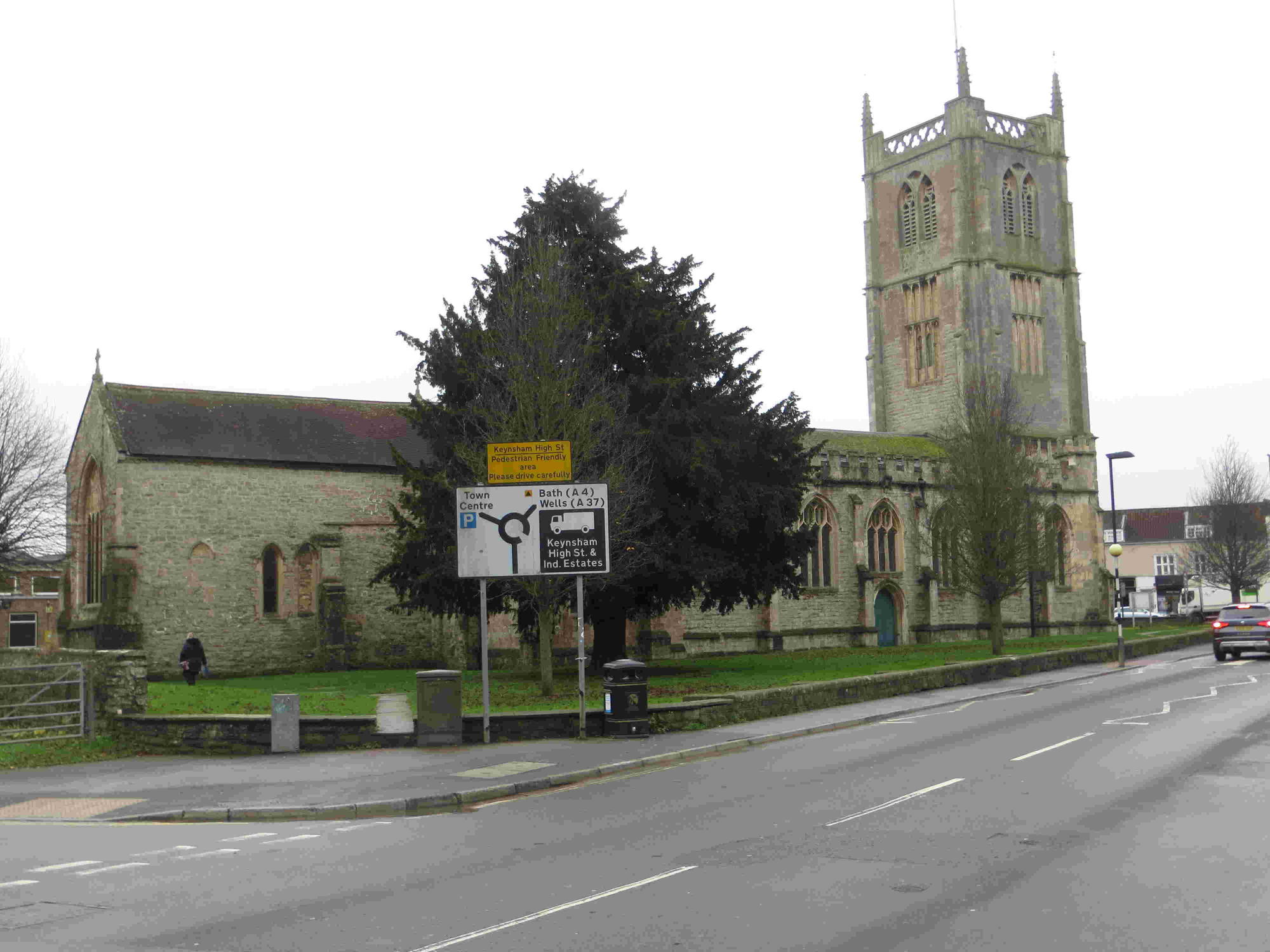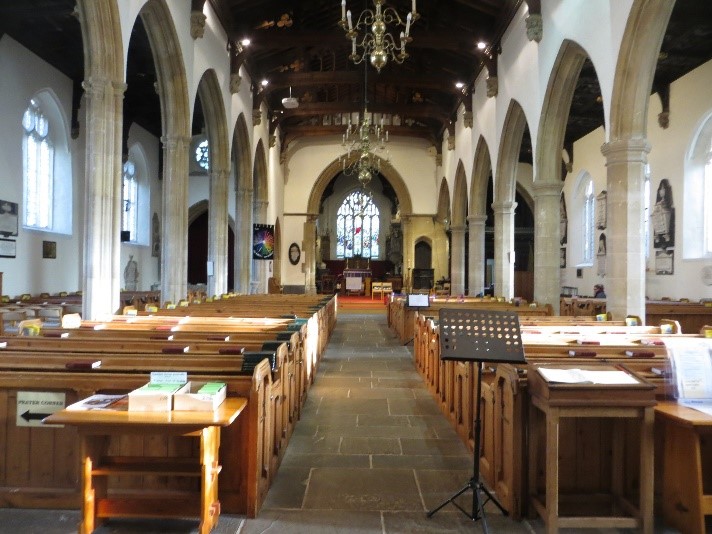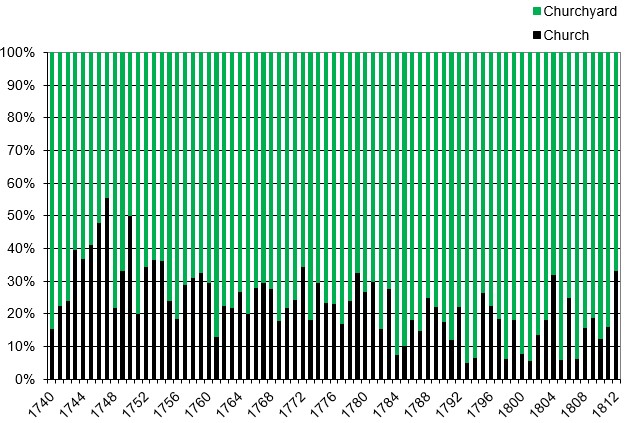
St John's, Keynsham
From the Bath Chronicle of Thu 27 Jan 1842 p3:
On Saturday night week a great part of the lead on the roof of Keynsham church was stripped and carried away. The thieves were alarmed in their proceedings by the fall of a part of the wall, which made much noise, and was heard by some neighbours. The lead, which weighed upwards of 4cwt., has since been found in a lime kiln at no great distance.
(4cwt = 200kg)
From the Bath Chronicle of Thu 31 Dec 1846 p3:
A CHAT ABOUT KEYNSHAM AND BITTON
. . . Keynsham (St. Keyn’s ham) church has some parts of great beauty, especially the west end of the south aisle, with its stairs turret, and deserve better treatment than it has received or is promised. The south porch has fallen into ruin, and it was gravely proposed, a short time ago, to pull it down, as the cheapest way of repairing it! Fortunately a defender was found, and it is hoped that he will succeed in inducing the parishioners to restore it. Keynsham church is remarkable for a perpendicular gothic tower, rebuilt as late as the year 1612, at a cost of £230. The details, as may be expected, are bad, but the general proportions are satisfactory. It has usually been described as of the late perpendicular period, and the writer of the “Church Notes,” in Bourne’s fine work on the Great Western Railway, (Mr. George Clark), has fallen into the same mistake. . . .
As reported in various newspapers a possibly valuable painting was discovered in the church’s vestry. The following is from the Royal Cornwall Gazette of Fri 16 May 1851 p7:
CURIOUS DISCOVERY.―For years beyond the memory of any parishioner now living, there have been hanging in the vestry of Keynsham Church two old pictures, hardly traceable through dirt and smoke. A short time since, however, somebody took to washing them with soap and water, when one was discovered to be a fine old painting of St. Cecilia; the other represented the passion of our Lord, and was so remarkable a picture that the vestry began to inquire among the parishioners of they knew anything about its origin. One very old woman said she recollected hearing, when she was a girl, that it was painted “by some foreign painter,” and after a little, recollected his name was “Master Holbein.” The old woman knew nothing of art, and her authority is therefore a valuable one, as showing the tradition of a name which she could not otherwise have heard; besides the picture is marked by those striking peculiarities which distinguish the pencil of this old master. The vicar at once claimed the picture as his property. The vestry, however, dispute his right.
The account in The Durham County Advertiser ascribes both paintings to Holbein.
From The Wells Journal of Sat 6 Nov 1852 p8:
On Sunday last, Keynsham Church was re-opened for Divine Service, having been closed for some weeks for the purpose of repairing, colouring, and cleaning the old edifice. The whole of the yellow colouring has been scraped off all the pillars, so as to show the freestone; and some of the old windows, with the heavy iron bars and old glass have been removed from the south side, and modern ones substituted. A subscription has been raised for the purpose of purchasing two new chairs for the Chancel.
From the Bath Chronicle of Thu 19 Jul 1855 p3:
This city and its neighbourhood was visited by a severe thunderstorm on Saturday morning last. The rain fell in torrents, beating down the garden and other crops. One of the pinnacles of Keynsham Church was struck by lightning.
From the Bath Chronicle of Thu 8 Nov 1855 p5:
KEYNSHAM.―SACRILEGE. One night during the latter part of last week, about three cwt. of lead was stolen from the roof of Keynsham Church. The footsteps of two persons were distinctly traced in the churchyard, which may lead to the apprehension of the guilty parties. A reward has been offered by Mr. Floor, Agent of the Property Protection Society, to any person who will give such information as shall lead to the conviction of the offenders.
From the Western Daily Press of Wed 26 Jun 1861 p2:
On Sunday last a public notice was given by the Vicar to his congregation to this effect―that as during the past week a considerable portion of the chancel ceiling had fallen down, and it might be at the risk of life to make use of that part of the church in its present state, the Sacrament of the Lord’s Supper should not be administered till a license could be obtained from the Bishop to have Divine service and the Lord’s Supper in the Parochial Schoolrooms. The parishioners of Keynsham are now making an earnest effort to restore their fine old church, which is very large, and in a very bad state, and therefore requires to have at least £2,500 expended upon it to make it decent and safe. In another column there is an advertisement from the Vicar and Church-wardens, showing that the parishioners have come forward and done their utmost, and that £900 still remains to be made up, and for which they earnestly appeal to the public. The case is urgent and well worthy of support.
From the Bath Chronicle of Thu 27 Jun 1861 p4:
REPAIR and RESTORATION of KEYNSHAM
CHURCH, Somerset
SECOND APPEAL
The present condition of this Church is such as to render it almost unfit for the celebration of Divine worship, and calls imperatively for immediate and extensive repairs.
It is proposed, should funds be forthcoming, to take off the present roof, which is in a very bad and unsafe state, and to put on one entirely new.; to take down and rebuild the two rows of pillars, which considerably out of the perpendicular; and also to re-seat the entire church, the old pews being in a most wretched condition, and by this means, to afford ample accommodation for the congregation.
There have been already two attempts made to restore this church; the first in the year 1831, at the request of the Bishop of the Diocese; the second in 1843, when the architect employed to survey the church, reported that the pillars and sidewalls were giving way, and that the roof was gradually sinking. Both these attempts failed on account of the expense of the extensive repairs required.
A third attempt is now being made, which it is hoped may move successful, as the Landowners and Ratepayers have come forward most willingly, and within one month contributed £1,000, to which a few other friends have added £600, and the working men of the parish £27, so that the total amount now promised or received is £1,627.
As, however, it is estimated that, at the least, Two Thousand Five Hundred Pounds will be required to carry out the entire work, and that little more can now be expected from the Parish, and inly £200 from the Church Building Societies, this appeal is made to the Public in the hope that they will aid the Parishioners of Keynsham to preserve their fine old Parish Church, which, two hundred years ago, was described in a Royal Brief as “A very fayre, large, and substantiall Church, and a great ornament to the sayde Towne.”
Curiously, despite the reports of the poor condition of the church, a marriage was held there on 21 Jul 1861.
From the Bath Chronicle of Thu 1 Aug 1861 p8:
Keynsham Church: The committee for the restoration of this church met on Friday last, for the purpose of inspecting the plans prepared by Mr. Ferry, architect, when the same unanimously adopted, and contracts will be advertised for, so that the necessary alterations may be immediately commenced. There is still some deficiency in the funds required to carry out the necessary alterations into effect, which it is hoped will soon be obtained.
Ironically, given the previous thefts, the lead on the roof of the church ‘except the gutters and flashings’ was offered for ‘sale by tender for cash’. (Bath Chronicle Thu 31 Oct 1861 p4). The Western Daily Press of Wed 23 Oct 1861 had an advertisement for ‘the whole of the Red Deal and Oak Pewing’.
The Incorporated Society for the Building and Repairing of Chapels made a grant (Bath Chronicle Thu 5 Dec 1861 p8).
From the Bath Chronicle of Thu 19 Dec 1861 p8:
Keynsham Church.―Tuesday evening, the 10th inst., between 7 and 8 o’clock, many persons in the vicinity of the church and passers by, were astonished by hearing a large crash and noise resembling distant thunder, and, on enquiring, it was discovered that a large portion of the roof and walls belonging to the chancel of the church had fallen down, in consequence, as it is supposed, of the roofs of the other portion of the edifice have been removed for the purpose of restoring the same. The above accident has caused several other portions of the building to be in a very dangerous position. Had the event happened whilst the men were at work, no doubt several lives would have been sacrificed.

From the Bath Chronicle of Thu 1 May 1862 p5 in an article on the reopening of Ken church (between Yatton and Clevedon):
The chancel is elaborately ornamented with carved oaken bosses, which have been cut from some wood supposed to be 500 years old, from Keynsham Church, which edifice is now undergoing restoration at the hands of Mr. Bennett,
The Bath Chronicle of Thu 28 May 1863 p5 reported in the reopening of the church on previous day after ‘undergoing a complete restoration, at a cost of over £4000’.
In the burial register an entry for a burial on 31 Mar 1710 has ‘was the first that was buried in the yeard wheare the Church stands’. Entries about this time specify the general location of the burial: ‘in ye Church-yard’, ‘in ye inner pt of ye Church’, ‘in ye outer pt of ye Church’, ‘in Mr Bridges’s Isle’. Presumably the ‘isle’ referred to was an aisle added to the church.

Precentage of burials in the church and churchyard
During the period 1741-1812, mainly between 20 and 30 percent of the burials were in the church.
In the period 1697-1812 the number of burials stated as being in the church is 613, compared with 2,044 in the churchyard.
The age profile has about 30% aged under 11 and 21% aged over 70.
Henry Swaish (1678-1773) is described in the burial register as ‘late gardener to Col Bridge & The Duke of Chandos’. The 1st Duke of Chandos from the second creation of this title was James Brydges (1673 - 1744) and he was made Duke of Chandos in 1719. The 3rd Duke of Chandos, also named James Brydges (1731-1789) was the last Duke of Chandos. The manor of Saltford was in the possession of the Dukes of Chandos. An article entitled ‘Keynsham’s Link with the Duke of Chandos’ by Sue Trude appeared in Around Keynsham & Saltford Past and Present (Series 2 No. 11, 2001).